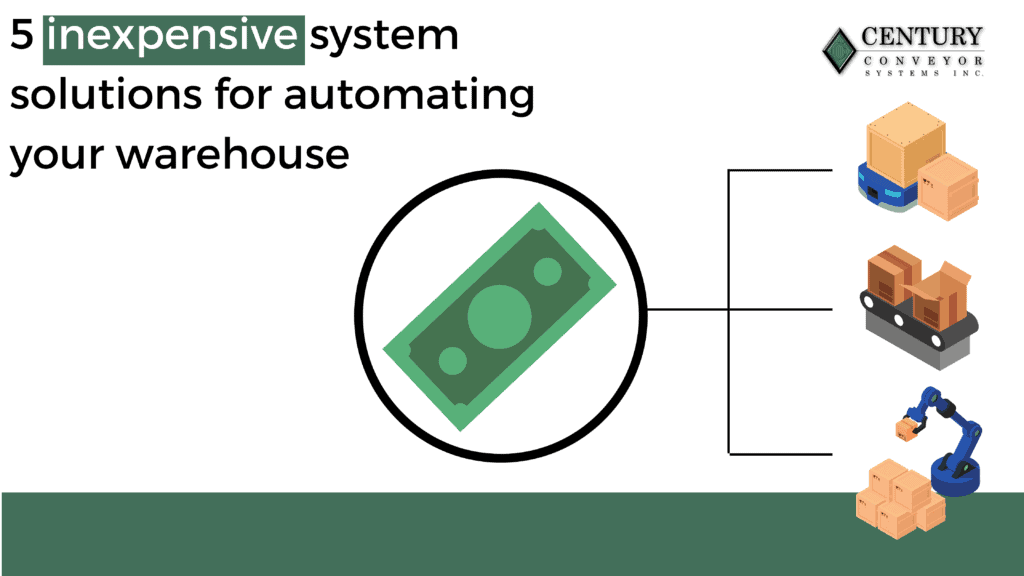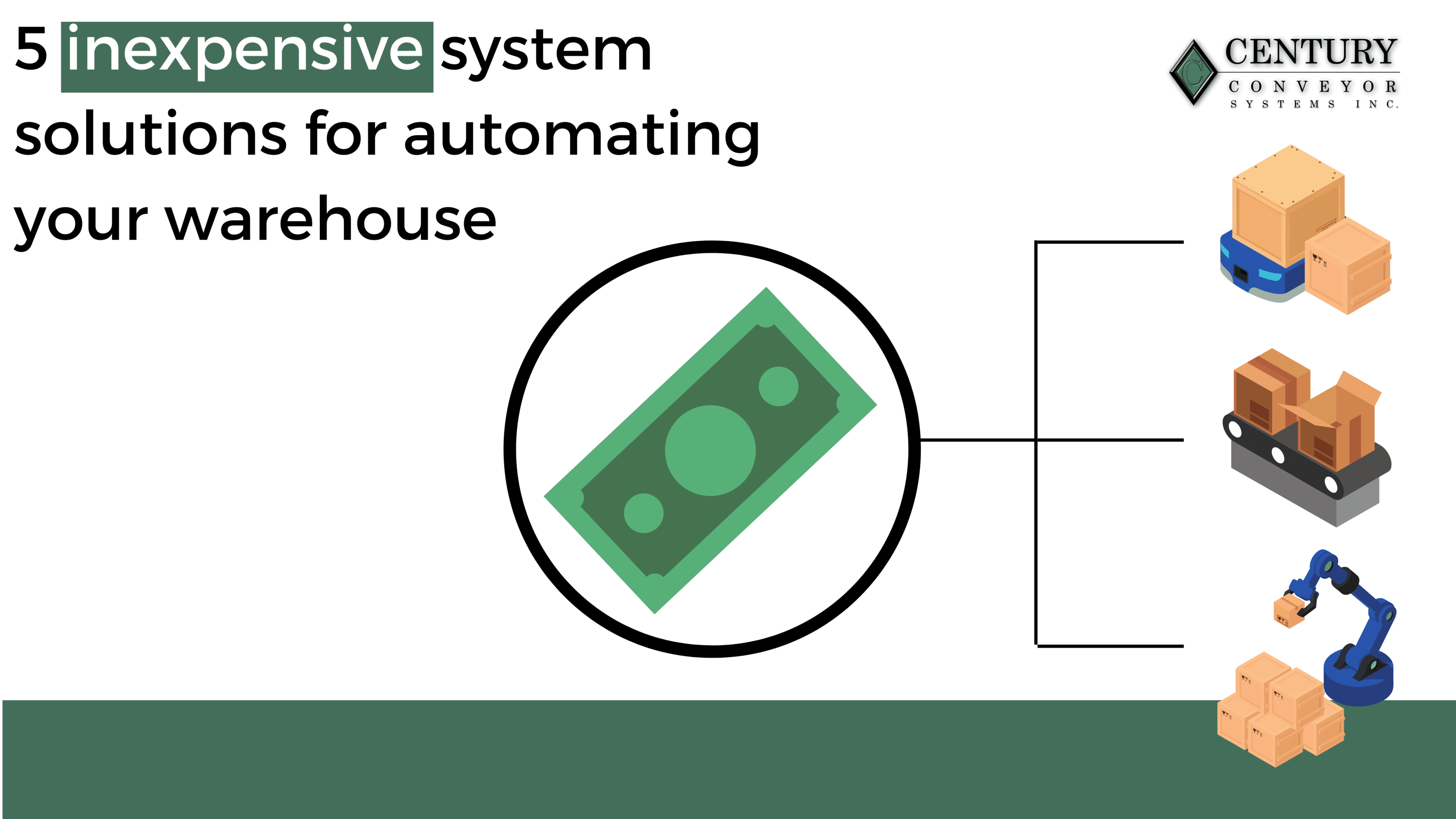
When the topic of integrating automation comes up, many warehouses are quick to say “too expensive”, and then proceed to purchase another forklift for $100,000.
Automation systems have advanced to the point that many solutions can be deployed inexpensively as a single addition, and are flexible enough to integrate with existing systems. The material handling industry itself has exploded in recent years, with hundreds of new automation solutions being developed and utilized.
With new innovations, each use case becomes more specific, ensuring that there’s a solution out there that fits your budget and functional needs. The difficult part is selecting the system that provides the most bang for your buck.
Century Conveyor Systems has operated through decades of automation developments and understands which systems are the ideal solution to your distribution needs, keeping in mind the importance of budgetary restrictions.
Here are our recommendations for relatively inexpensive automation systems.
Palletizing Systems
Manually building a pallet can be a pain, and the impreciseness in doing so can lead to carton damage and unstable pallets. If your warehouse has experienced a recent increase in demand, manual pallet building may not be able to keep up, leading to jams and packages waiting to be palletized.
Deploying a single robotic arm in a cell can solve this issue, and far outpace anything an operator could do. In conjunction with a robotic arm, pallets can then be moved to a stretch-wrapper machine (another inexpensive solution). What if your facility only breaks, not builds pallets? Robotic arms can complete depalletizing operations as well.
The functionality doesn’t end there, though. The end-of-arm tooling can be swapped out for different end-of-line handling functions. Some include, but are not limited to:
- Case forming and erecting
- Carton sortation
- Order packing
The bulk of the cost associated with using a robotic arm comes from the initial purchase and installation. Integrating one arm would cost a bit north of $100,000, and can get more costly as accessories are added, but a return on investment of a year and a half should be expected. Keep in mind that some robotic arm manufacturers offer leasing agreements, which can help with procuring a system and spreading out associated costs.
Ergonomic Picking
Enabling easy handling of products for your picking operations can make a substantial difference when a storage module isn’t just a static structure. Re-engineering how your warehouse staff store and retrieve items can decrease the time it takes for product to be processed, and offers a much more stable alternative to typical picking operations.
Canted gravity racks utilize skate wheel sections to make retrieval easy. Employees can then place cartons on an infeed conveyor to be staged or moved to downstream operations. Product can then be re-slotted in the racks, maintaining a continuous flow. Various storage modules can be customized precisely to the specifications of the warehouse, and how the product is processed, but the general idea of primarily using gravity as opposed to photo eyes and motors keeps projects inexpensive for these solutions.
Century recently completed a system project that utilized effective picking modules, with care taken with respect to employee ergonomics and handling. This project shows that, despite the size of the warehouse and its limitations, automation can successfully be integrated.
Warehouse Management System
Before integrating any other solution, a WMS should be considered. Even without automation tied into a WMS (through a WCS), the visibility and data it provides is extremely valuable. From receiving, picking, processing, shipping, tracking, and reporting – every product touchpoint is recorded and made visible for operators to view.
WMS platforms vary differently in price and functionality, and most operate on a monthly payment plan or an annual licensure. Expect to spend $1,500 – $4,500 per month (average of around $35,000 yearly). Some WMS providers have additional licenses for extra users, which can average under $1000 each.
While not a massively cheap solution, the reporting of every action in your distribution center grants a powerful understanding of its performance and daily operations. Use that knowledge to make decisions on future warehouse process improvements and demand forecasting.
EOL Loading Systems
Depending on your end-of-line operations, loading can quickly become an area of blockage if manual operations are still being used, or if your output exceeds that of what can be reasonably loaded in the time allotted. Slow loading can contribute to downstream jams, product damage, inefficient placement, as well as unhappy truckers.
If your facility employees a few operators to hand load trucks, enable automation systems to make their job easier and faster. Extendable conveyors are a must-have when loading. Non-powered skatewheel extendables on casters can be manually adjusted to accommodate for variable loading positions, and keeps a congruent line of packages to the operator. These types of mobile conveyors are very common, and can be purchased inexpensively (especially when used). Expect to spend a few thousand.
For a more automated system, a powered extendable can be deployed, which provides operator controls to extend into and retract out of a trailer. The belt is powered, and can use sensors to properly gap products as they are being loaded. Expect to spend considerably more on a powered extendable. Depending on the manufacturer and options added, the range can vary between $50,000-$125,000.
Single Robotic Deployment
The most common warehouse robots are categorized into two applications. Automated Guided Vehicles (AGV) and Autonomous Mobile Vehicles (AMR).
AGVs and AMRs both provide a multitude of functions, typically moving items from one area of the facility to another, absent of human interaction. The difference between the two is in the way it senses the environment. AGVs move by using a sensor that follows a set path (typically a form of sticker or tape on the ground). AMRs move by sensing objects around them and learning an optimal path. In this sense, both have applications that one or the other is better suited to.
Larger distribution centers that employ AGVS and AMRS will typically have a fleet of them, which typically isn’t an inexpensive investment. The real savings come in based on what’s being deprecated in lieu of a warehouse robot. Deploying a single AGV or AMR to replace a new forklift (and the labor needed to operate it) can make a quick return on investment.
Most AGV and AMR systems start around $30,000 and trend upwards the larger and more advanced they get. Deploying a single robot in your warehouse to move pallets or oversized items (non-conveyable) makes the most sense in a use case. If you’re looking to complete picking or fulfillment operations, a few more robots would have to be deployed in order to match the fulfillment speed of the operators (3 robots per picker on average).
Consider the layout and the complexity of your operations. If it’s a relatively simple A to B task that is done on a recurring basis, an AGV or AMR might be a likely alternative for those not looking to fully automate. For example, taking completed pallets from a palletizing area to an end-of-line loading operation. An AGV or AMR can be programmed to follow the same route every day, sans the need for a lift truck and operator.



